September 25, 2015
Air Date: September 25, 2015
FULL SHOW
SEGMENTS
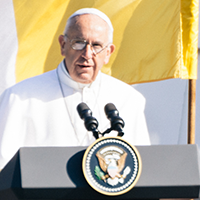
The Pope at Congress: Care for Nature and the Poor
View the page for this story
Pope Francis is the first pontiff to address a joint meeting of Congress. He accompanied forceful words on care for the poor, and the planet with warmth and appreciation for America’s role as a creative and welcoming nation of immigrants. (14:10)
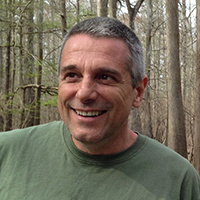
Louisiana’s Swamp Defenders
/ Emmett FitzgeraldView the page for this story
Once, cypress swamps covered hundreds of thousands of acres across the American South. Logging, oil and gas extraction and swamp drainage transformed the landscape. But over recent years, Dean Wilson has worked to protect the remaining cypress swamps of Louisiana’s Atchafalaya Basin from illegal loggers and oil prospectors. Recently, the European biomass industry has set up shop in the state, and conservationists are concerned for the future. Living on Earth’s Emmett FitzGerald reports. (17:10)
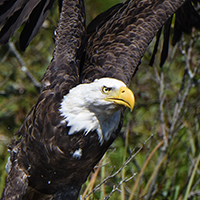
The Federal Conservation Fund Endangered
/ Derrick JacksonView the page for this story
Essayist Derrick Jackson reflects on the role the Land and Water Conservation Fund has played in preserving prairies and forests, coasts and city green space. But Congress may not meet a deadline to reauthorize and fund it. (02:20)
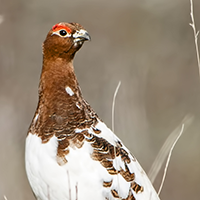
BirdNote: Voices of Our Public Lands
/ Mary McCannView the page for this story
We the People own nearly 850 million square acres of US public land and ocean, and as BirdNote’s Mary McCann points out, these spaces provide vital habitat for over a thousand diverse species — from the Bachman’s Sparrow in the Southeast to Alaska’s Willow ptarmigan. (02:00)
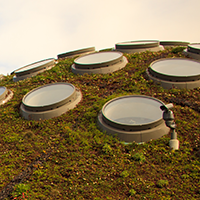
Beyond the Headlines
/ Peter DykstraView the page for this story
In this week’s trip beyond the headlines, Peter Dykstra and host Steve Curwood discuss the redesign that includes a green roof, meant to save a dying mall, American conservatives’ domination of climate denial, and one Reverend’s conviction that he “prayed away” a hurricane. (04:30)
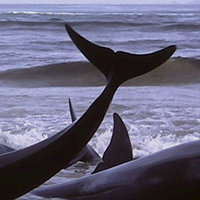
Saving Whales From Deafness
View the page for this story
Numerous scientific studies link underwater sonar and explosives use and ship strikes to thousands of marine mammal deaths, mass strandings and damage. The Natural Resoures Defense Fund filed a suit to challenge a U.S. Naval plan to conduct testing off Hawai’i and southern California. NRDC senior attorney Zak Smith tells host Steve Curwood about their case how the ruling will help protect marine populations and habitats from harmful Naval assaults. (07:30)
Online Exclusive: Airing Volkswagen’s Dirty Emissions
View the page for this story
Recently, a small group of scientists uncovered that Volkswagen had installed software on its small diesel vehicles that allowed them to cheat on emissions tests to meet EPA clean air standards. Host Steve Curwood speaks with Dave Cooke, a vehicles analyst with Union of Concerned Scientists, about the carmaker’s incentive to cheat and if “clean diesel” is possible. (06:21)
Show Credits and Funders
Show Transcript
HOST: Steve Curwood
GUESTS: Alan Lowenthal, Bob Inglis, Zak Smith
REPORTERS: Emmett FitzGerald, Derrick Jackson, Mary McMann, Peter Dykstra
CURWOOD: From Public Radio International, this is Living on Earth.
[THEME]
CURWOOD: I'm Steve Curwood. Millions celebrate the US visit of the charismatic Pope Francis, where he spoke about our duty to the poor, to every living thing and to our planet.
POPE: Now is the time for a “culture of care” — combating poverty, and, at the same time, protecting nature.
CURWOOD: The power of the Pope’s words in America. Also, forests in the southern US are being cut down to provide wood pellets for European power, thanks to EU renewable energy subsidies.
MACON: If the subsidy structures were not in place that were incentivizing renewable energy this would not be an economically feasible industry. I mean, they are getting wood from one country shipping it all the way across the Atlantic and then just burning it in a power station, so it’s not that efficient.
CURWOOD: That and more this week on Living on Earth. Stick around.
[NEWSBREAK MUSIC: Boards Of Canada “Zoetrope” from “In A Beautiful Place Out In The Country” (Warp Records 2000)]
ANNOUNCER: Support for Living on Earth comes from United Technologies, innovating to make the world a better, more sustainable, place to live.
The Pope at Congress: Care for Nature and the Poor
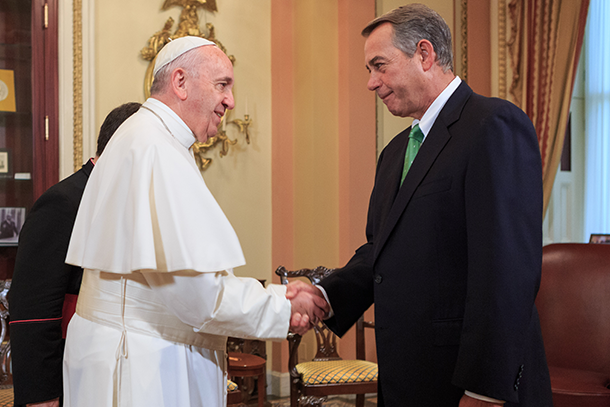
House Speaker John Boehner, a devout Catholic, welcomes Pope Francis before the Holy Father’s speech to a joint session of Congress. (Photo: Speaker John Boehner, Flickr CC BY-NC 2.0)
CURWOOD: From the Jennifer and Ted Stanley Studios at the University of Massachusetts Boston and PRI, this is Living on Earth. I’m Steve Curwood.
SERGEANT AT ARMS: Mr Speaker, the Pope of the Holy See.
CURWOOD: Pope Francis has kept a busy schedule on his tour of America. He has celebrated large and even larger Masses, and spoke directly about the urgent need to address climate change to crowds at the White House, and delegates at the United Nations. But he was more measured in his speech to a joint session of Congress, a Congress that has yet to enact any comprehensive climate protection.
POPE FRANCIS: Mr. Vice President, Mr Speaker, honorable members of Congress, dear friends. I am most grateful for the invitation to address this joint session of Congress in the land of the free and home of the brave.
[APPLAUSE]
CURWOOD: His speech was graceful and his words well-chosen, with plenty to please the public as well as the lawmakers, and he urged them to keep in mind the dignity of all human life and the need to protect it. The Pope cited America’s history as he spoke of liberty and dreams, inclusiveness, economic justice and peace. Pope Francis has been critical of the excesses of capitalism, but before Congress he called business “a noble occupation”, especially when it creates jobs and sustainably uses resources for the common good.
POPE FRANCIS: This common good also includes the Earth, a central theme of the encyclical which I recently wrote in order to enter into dialogue with all people about our common home. We need a conversation which includes everyone, since the environmental challenge we are undergoing, and its human roots, concern and affect us all. In Laudato Si, I call for a courageous and responsible effort to redirect our steps, and to avert the most serious effects of the environmental deterioration caused by human activity. I am convinced that we can make a difference. I have no doubt that the United States, and this Congress, have an important role to play. Now is the time for courageous actions and strategies, aimed at implementing a culture of care and an integrated approach to combating poverty, restoring dignity to the excluded, and at the same time protecting nature.
CURWOOD: The chamber was packed. Members of the House, the Senate, the Supreme Court justices, and the cabinet were all there and the applause was often long and loud. We called up Representative Alan Lowenthal, Democrat of California and chair of the Safe Climate Caucus for his reaction.
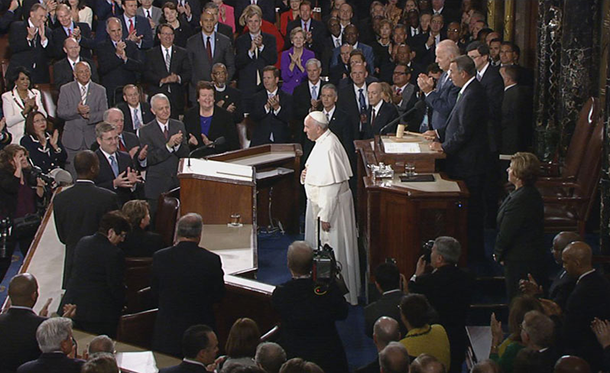
Pope Francis was the first pontiff ever to address a joint session of the United States Congress. (Photo: House Office of Photography)
LOWENTHAL: You know, it really touched on all the aspects that the Pope had written about in the encyclical. One of the things that struck me is the Pope has a way of presenting very controversial issues in a very positive way; what needs to be done, rather than to point his finger and blame, and I think that came through.
CURWOOD: What was the mood in the chamber when the Pope was talking?
LOWENTHAL: You know, the excitement in the place, it was electric in the chambers. It was very interesting when he began to talk about climate change. All the democrats jumped up and supported him, and one or two Republicans did, and then a few more Republicans did and you gradually saw Republicans, at least some of them, beginning to step up and to acknowledge. It was one of the few times where there was a real difference between the response of members of Congress.
CURWOOD: When the Pope spoke in the public session with President Obama, he said that climate change is a problem that can no longer be left to future generations, yet in front of the Congress, he didn't actually mention the words climate change. What you make of that?
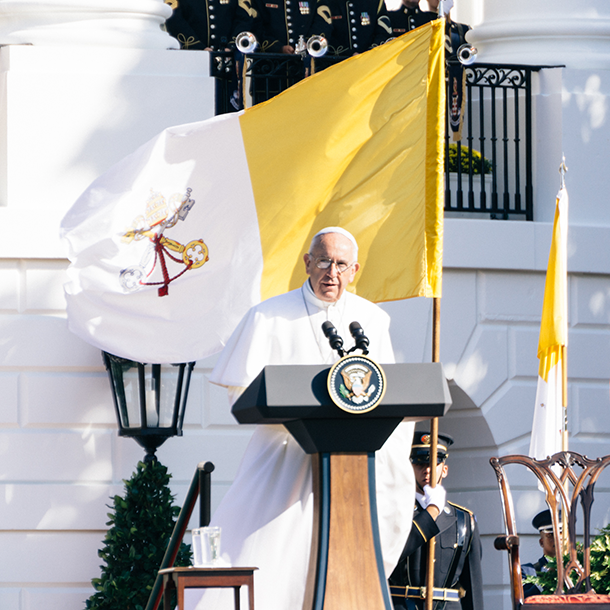
Pope Francis spoke on the White House South Lawn on Wednesday, September 23rd. In that speech, he used the words like “climate change,” in contrast with his address to Congress the following day. (Photo: James Jackson, Flickr CC BY-ND 2.0)
LOWENTHAL: Well I don't make anything of it...I think the most important thing is he called upon Congress to take courageous actions and strategies in implementing what he called a culture of care and I think that's very important, which was an integrated approach to combating poverty, restoring dignity to the excluded. He talked about, at the same time, the need to protect nature and that really we now have to devise, as he pointed out, intelligent ways to limit our power, to put technology in the service of a healthy and more humane and more social and a more integrated approach. He did not directly mention the words “climate change”, but it was really clear that he linked the changes in the planet, that he was saying that those that are most affected or will be are those that are poor, those that have little voice and we have a responsibility here as elected officials to come up with actions and strategies to protect those that are most vulnerable, and not just in terms of inequality, which he did talk about, but also about the impacts of climate.
CURWOOD: So in other words, the Pope is a master politician here, not actually saying “climate change” in front of the Congress when it's safe to say so at the UN or at the White House. Why is that politic, do you think?
LOWENTHAL: Well, I think the Pope's overarching message was it is time to come together to solve these problems. He was interested in identifying the problems but not antagonizing people to such an extent that they would not work together. And I kind of adopted the same techniques on the safe climate caucus. What I did when I took it over; there were 47 members and they were all Democrats, and I've spent a great deal of time reaching out to Republicans, talking about how can we work together on the issues of climate change?
CURWOOD: So how many Republicans do you have?
LOWENTHAL: Well, we waited until the Republicans put out their own resolution talking about climate change, I think under Mr. Gibson and I think there were 10 Republicans and we now would like to sit down with those and others. And I think they've worked very hard at at least identifying 10 Republicans who acknowledge that changing of climate has to do with human activity and I think that's the first time they've ever acknowledged that publicly and put it into a resolution, and I think that's a great first step.
CURWOOD: The Senate side, led by Maria Cantwell, the Democrat from Washington state, has filed a bill on climate that she says obviously won't move unless and until there's a Senate majority after the election, but what you make of this filing and what do you think the Pope's appearance does for the prospects for that kind of legislation?
LOWENTHAL: I believe that it is been since the late 1990s that climate and environmental issues had reached a tipping point of critical importance, and I think that what has happened was that shortly after we began the 21st century it became the 9/11 issue and even though everybody knew, we talked about it, it became less of a important issue. We were dealing with survival, we were dealing with terrorism, we were dealing with the instability throughout the world and climate change dropped off the radar. I think what is occurring and one of the things about the Pope's message is it's part of your call to solving some of the problems of the world whether it’s immigration, whether it's climate change. You cannot separate these problems, and it's time for these to emerge as the major issues before us, and so I think the issue is to reelevate the status of the environmental danger that confronts us.
CURWOOD: That’s Congressman Alan Lowenthal, Democrat of California. For a Republican perspective, we called former Congressman Bob Inglis of South Carolina.
INGLIS: Well, I heard him talk about the spirit of enterprise, which is very exciting because that's what we think can fix climate change.
CURWOOD: In the well of the house, he never used the words carbon, or climate, or ecology. Why do you think that was?
INGLIS: I don't know. I wondered about that. I think that his comments in the encyclical could at least speak for themselves. But I think he was definitely onto something. He was talking about the spirit of enterprise and congratulating America on that. That may have been a way of reaching the crucial constituency for action which is actually conservatives in America and so, by congratulating the spirit of enterprise and maybe applying that to climate change, but not using the words “climate change”, he was doing something very effective, reaching into the hearts and through the hearts and into the minds of fellow conservatives.
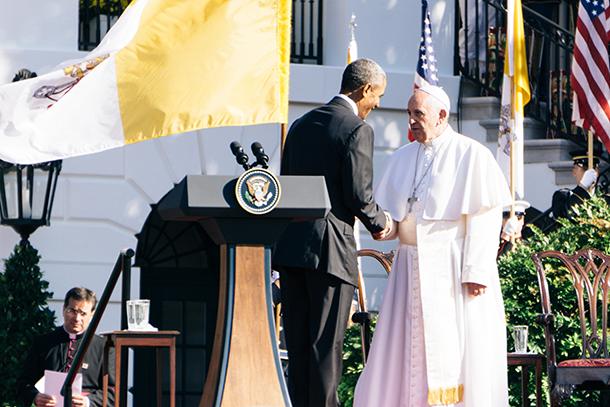
President Obama welcomes Pope Francis to the South Lawn stage. (Photo: James Jackson, Flickr CC BY-ND 2.0)
CURWOOD: Now, famously there have been some Republican candidates for President who have pooh-poohed the Pope speaking out on climate and his big encyclical. Overall how do you think the main body of Republican lawmakers responded to the Pope?
INGLIS: Well, I was very heartened by the speech because I think that he's talking about things of the heart, and when it comes to action on climate change it's mostly a matter of the heart. The head's very clear on climate change, the science is pretty clear, the economics are even clearer that there is a very easy answer which is just: eliminate all the substitutes for all the fuels, attach all the costs to all the fuels and the free enterprise system will sort it out. I think that there is a tendency to minimize the importance of faith. The gospel is much bigger than most of us are thinking and that there really is quite an answer at the cross for the redemption of all of creation, and so limiting that, saying that somehow the Pope isn't qualified to speak on the stewardship of the Earth seems to me a rather strange limitation to place on him.
CURWOOD: The Pope was very strong speaking about the right to life in his address to Congress, a number of ways that he took that message. One was to oppose a death penalty and others to lift people up out of poverty, but clearly another way is the right for our living systems on the planet that support us. What was your take on that?

Congressman Alan Lowenthal is the United States Representative for California’s 47th congressional district. (Photo: United States Congress, Wikimedia Commons public domain)
INGLIS: Well, I think he's on solid ground there, that applying that what some may think broadly to creation care is not really that far away from being pro-life. I mean, is it all the same thing? You see, we have to preserve a sustainable system in order to have life on this beautiful planet that we've been given.
CURWOOD: The Pope didn't come out strongly against capitalism in his speech in front of Congress. He did say that there's a right and proper way to use natural resources though. What do you make of that?
INGLIS: I think that the Pope is actually right to question capitalism unrestrained by Judeo-Christian ethic. If it's not restrained, then capitalism is really a pretty lousy system. Communism might be better because at least it starts with the fiction that we're all going to share and share alike. Now, it never works out that way, but the strong message is biblical accountability. Making it so that I can't do on my property something that harms your property and the specific application to climate change, of course, is that currently, fossil fuels are allowed to socialize their soot. It means that if I make electricity from fossil fuels I'm able just to dump into the trash dump of the sky, foul up other people's lungs, foul up their property, and what the Pope seems to me is on solid ground is speaking of that kind of accountability, and if he puts it into the context of creation care that's a fine place to put it, and if he wants to expand that and say that that's protection of life itself, well he’d be correct in that; and it is, in fact, pro-life to talk about sustainability in that way.
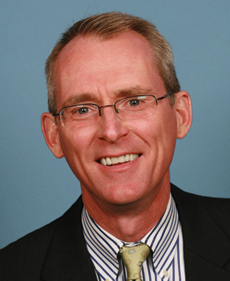
Bob Inglis is a former United States Representative for South Carolina’s 4th congressional district. (Photo: United States Congress, Wikimedia Commons public domain)
CURWOOD: Conservative denominations have been very strong in politics; what influence does this appearance by the Pope have on where things go from here?
INGLIS: This is possibly one of a series of turning points where we expand the constituency for action. Climate change has been a conversation started by the environmental left, it's a conversation that conservatives don't feel so comfortable entering, but when you have a very conservative institution, the Catholic Church, entering the conversation, it brings an opening for conservatives. C,ertainly for conservative Catholics, but also for others of conservative faith to agree with the Pope on many things and the teachings of the church on many things. So it could be a game changer in that it's adding new people to the conversation.
CURWOOD: Former Republican Congressman Bob Inglis of South Carolina. Just ahead...fighting to save the Cypress swamps of Louisiana. Stay tuned to Living on Earth.
Related links:
- Pope Francis Skirts Environmental Tussles in Address to Congress
- The transcript of Pope Francis’s speech to Congress
- A complete schedule of the Pope’s visit to the U.S.
- U.S. Congressman Alan Lowenthal
- About the Safe Climate Caucus
- A previous Living on Earth conversation with Bob Inglis
- Bob Inglis is Executive Director of the Energy and Enterprise Initiative
Louisiana’s Swamp Defenders
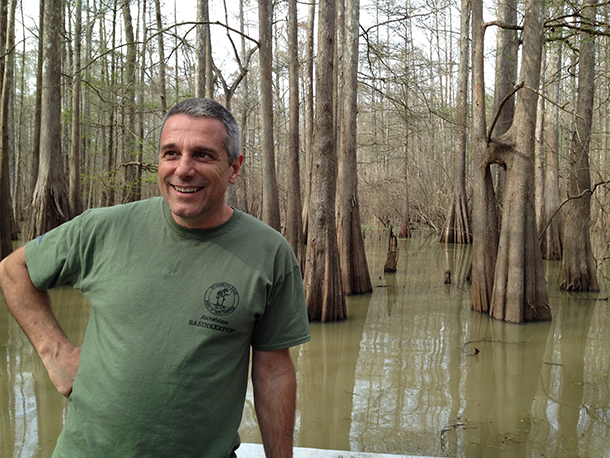
Dean Wilson. (Photo: Emmett FitzGerald)
CURWOOD: It's Living on Earth, I'm Steve Curwood. If you drive from New Orleans to Baton Rouge, you might notice that much of the road is built on stilts. That’s because there’s little solid ground in Southern Louisiana. But there is a fair amount of wetland, with trees rising up out of the water. Cypress swamp used to cover much of the American South, but today it’s only found in isolated pockets. The Atchafalaya Basin in Louisiana is one of the country’s last great Cypress swamps, and that’s where Living On Earth’s Emmett FitzGerald met up with a man determined to help save it.
FITZGERALD: Dean Wilson doesn’t sound like a Cajun, but he’s been living in the swamps of Southern Louisiana for 30 years now.
WILSON: I remember the first time I saw the swamp I fell in love with it. You know you see the beautiful green trees, with the Spanish moss, over water, and those egrets flying around like angels. Uh, I just really fell in love with that.
FITZGERALD: Dean grew up outside of Madrid, in Spain, but he came to Louisiana in his early twenties on his way to South America. He wanted to get used to the humidity and the mosquitoes before doing scientific research in the Amazon. But he never left the Bayou State.
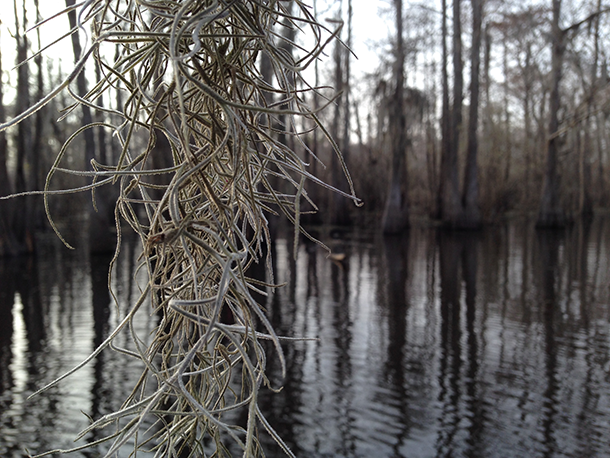
Spanish moss (Photo: Emmett FitzGerald)
WILSON: When I realized I could actually make a living off the land, I decided to stay. I was a commercial fisherman for 16 years, full-time. So I made my living hunting and fishing the swamps in the Atchafalaya Basin for 16 years.
FITZGERALD: Dean says people call all kinds of marshy wetlands swamps, but true swamps are actually pretty rare, and the Atchafalaya Basin is the largest in the United States.
WILSON: And the difference between a swamp and a marsh is that a swamp is a flooded forest. So you actually go in the springtime when the waters high you go with a boat through the forest and you can see the birds and the animals the otters minks alligators all the things that live in the swamp. It’s a magnificent place. One of the most beautiful places on earth. The Cypress trees grows to different shapes; they can live to up to 4000 years old. So the Cypresses are incredibly beautiful.
FITZGERALD: A few years ago, Dean gave up commercial fishing and turned his attention to protecting the ancient Cypress forest he calls home. Now, Dean patrols the swamp in his little motorboat as the head of the conservation organization Atchafalaya Basinkeeper. Today Dean and I are joined in his boat by his German Shepherd Shanka, and a fellow conservationist.
ORR: I’m Paul Orr and I’m Lower Mississippi Riverkeeper.
FITZGERALD: Mississippi Riverkeeper is another environmental organization devoted to protecting the area’s wetland resources. Paul unties our boat and we push off into the channel.
ORR: Here we go.
[MOTOR NOISE]
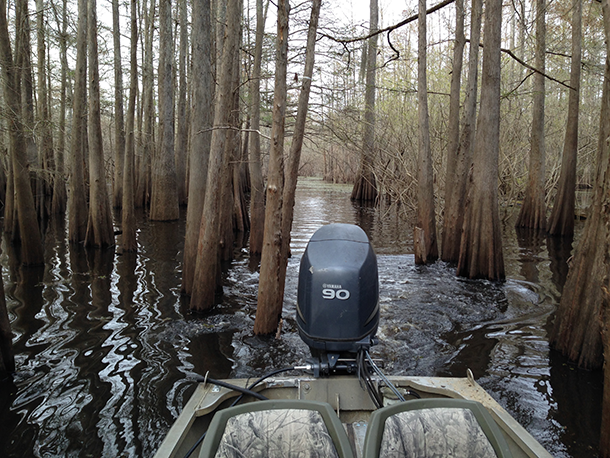
Floating through the cypress swamp (Photo: Emmett FitzGerald)
FITZGERALD: Dean steers the boat out of the main channel into the flooded forest. The depth of the water in here varies with the seasons. It’s early spring, when the water level is low, and our boat gets stuck on the mucky bottom.
ORR: The water, you know, as the snow melts up north the Mississippi River rises, but obviously we haven’t gotten to a high enough of a rise to get through here yet.
FITZGERALD: Right
ORR: Do you want me to push while you steer?
WILSON: Yeah, that would be good. Thank you Paul.
FITZGERALD: There we go. We’re free.
ORR: Always an adventure.
[BOAT NOISES]
FITZGERALD: Dean pulls the boat through the undergrowth into a clearing in the forest, and suddenly hundreds of giant cypress trees are all around us. Their trunks flare out at the bottom like grass skirts. Dean says this cypress forest is teeming with life.
WILSON: The swamps of the Atchafalaya are considered by scientists the most productive in the entire world. You can go to the Amazon and you may have more biodiversity, but if you get an acre of the Atchafalaya Basin and you’re supposed to get more pounds of fish and crawfish than any other wetlands in the world.
FITZGERALD: Full-grown cypress trees have nooks and cavities that birds love to nest in.
WILSON: Nearly half of the waterfowl population in North America come at one time or another through the Atchafalaya basin. So it is a critically important ecosystem not only for North America but the whole western hemisphere.
FITZGERALD: As we float between the trunks, Dean says swamps like this one once covered much of the American South.
WILSON: Most people have seen the Amazon river flooding millions of acres of rainforest. The Mississippi used to do the same thing, used to flood 24 million acres of forest. For somebody to picture how big is 24 million acres, there was a time when you could get in a boat, right now this time of year and through this water, could go through this forest, and never leave the forest all the way to Missouri.
FITZGERALD: But that five-hundred-mile waterway didn’t last. A lucrative timber industry developed in Louisiana around 1700. And then in the 19th century new steamship technology allowed companies to log southern cypress forests quickly and efficiently.
WILSON: By the year 1900 it was the largest industry in coastal Louisiana, was the cypress logging industry. Uh, and people thought it would last forever. By 1920, it was all over. They logged every single forest in this state. Didn’t leave a single acre standing.
FITZGERALD: In 1927, the Mississippi River spilled its banks, killing hundreds of people and displacing hundreds of thousands in the most destructive flood in US history. The Army Corps of Engineers responded to the crisis by building levees all up and down the Mississippi to control the flow of the river. The levees were designed to protect cities like New Orleans, but they straight-jacketed the river and prevented the natural flooding of Louisiana’s cypress swamps.
WILSON: It drained all those forests. Farmers came in, they cut those trees down and today it’s mainly farmland. When people drive through Arkansas, Northern Louisiana, Mississippi through what is called the Delta area, it’s all farmland but it used to be like the Atchafalaya Basin.
FITZGERALD: Today although the Atchafalaya Basin is smaller than it once was, it’s still one of last great cypress swamps left in the United States. Like all swamps it’s protected under the federal Wetlands Protection Act, and Dean Wilson and Paul Orr want to do everything in their power to preserve it. In 2008, they noticed an uptick in illegal logging in the Atchafalaya. They followed the supply chain all the way to the garden mulch aisle.
ORR: We realized pretty quickly from following the logs and then finding bags of cypress mulch and following those to Wal-Mart, Lowes and Home Depot that there was this tremendous push to try and build a cypress mulch industry.
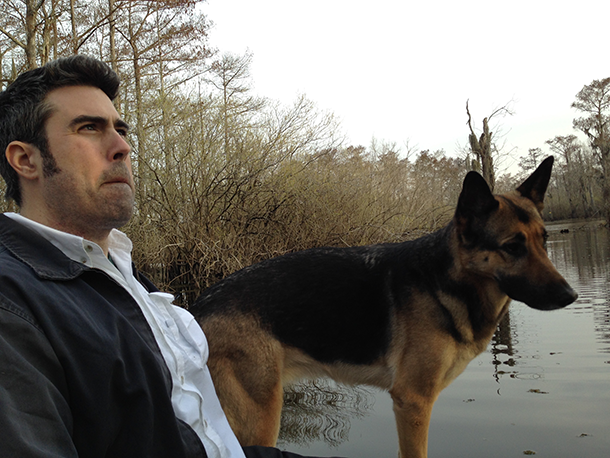
Paul Orr and his dog Shanka (Photo: Emmett FitzGerald)
FITZGERALD: But Dean says the companies that supplied the mulch weren’t clear about where it came from.
WILSON: Home Depot, Lowes and Wal-Mart were selling the mulch as environmentally harvested. The bags would say “Made with environmentally-harvested cypress, from Florida” – you have a Florida address, so they were actually deceiving the public into buying their mulch.
ORR: And deceiving the retailers — I think that some of the retailers were not very happy that that was not what they said it was.
FITZGERALD: So when Paul and Dean brought this issue to the attention of the retailers in 2008, the stores agreed to stop selling Louisiana Cypress mulch. But Dean’s still worried about illegal logging. He says the problem is enforcement.
WILSON: We have laws to protect wetlands, the problem is those laws are not being enforced, and the government isn’t even putting in the resources to enforce them, they don’t even have a boat, so they can’t be enforced.
FITZGERALD: And Paul Orr believes that problem starts with the cozy relationship between big business and the state government.
ORR: I guess it was like the late 90s, early 2000s, the Louisiana Department of Economic Development put an ad in a lot of national publications and it was like a guy in a suit doing a back bend and it said, “Louisiana bends over backwards for business”. And that’s really been the culture in Louisiana — the wealthy business people just give away all of our natural resources and our tax monies and everything for business.
FITZGERALD: Among the latest businesses to arrive in Louisiana are European power companies. In the past ten years, they have begun harvesting wood in the Southern US to burn for power back home. This type of electricity production is called biomass energy, and Adam Macon, campaign director with the environmental nonprofit the Dogwood Alliance, says that it’s taken off in Europe as the result of a decision to classify trees as renewable.
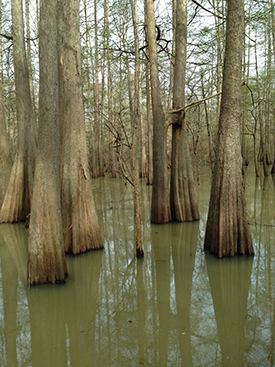
Cypress trees grow in standing water. (Photo: Emmett FitzGerald)
MACON: And it was really a mishap in an old IPCC report that essentially classified all forms of biomass as carbon neutral, meaning that when they burn them, they would be counted as zero in terms of countries counting their carbon emissions. So that really opened the floodgates for trees and forests to be chopped down and burned, because it was all being counted as carbon neutral.
FITZGERALD: Western Europe tightly regulates what forests it has left, so it’s easier for energy companies to come all the way over here to harvest trees from states like Louisiana, Mississippi, and North Carolina, where Adam Macon says a lot of the forests are on unregulated private land.
MACON: So essentially it’s the wild wild west of logging. Companies can come in and log anywhere, use any kind of logging practices generally unchecked. So it’s the perfect place for an expanding industry like the wood pellet industry to come in and be able to get a lot of wood very cheaply and very quickly.
FITZGERALD: And Adam says it’s only cheap because it’s getting EU renewable energy subsidies.
MACON: If the subsidy structures were not in place that were incentivizing renewable energy, this would not be an economically feasible industry. I mean, they are getting wood from one country, shipping it all the way across the Atlantic,, and then just burning it in a power station so it’s not that efficient. But currently, because of the subsidies, it’s a cheap form of energy.
FITZGERALD: There’s a simple logic to classifying biomass as renewable: trees grow back. If you cut down a tree and burn it for electricity, all you have to do is plant another one in its place to sequester all of the carbon that you emitted when you burned that first tree. But Adam says that doesn’t account for time.
MACON: The issue is that trees take a very long time to grow back, particularly these hardwoods in wetland forests that we’re working so hard to protect. And when you’re thinking about the carbon analysis from that perspective and in terms of mitigating the worst effects of climate change, we realize that we don’t have 50, 60, 70 years to wait.
FITZGERALD: In the meantime, some recent studies have found that burning biomass could pollute as much as or more than coal over a 50-year period.
MACON: We all know that coal is a dirty form of energy. And we need to move away from coal. But if the solution is to burn a form of energy that is emitting 3 times as much carbon into the atmosphere and count it as zero because the fact that 70 - 80 years from now, hypothetically, that forest is going to grow back, we have to acknowledge that we’re moving backwards there, not forwards.
FITZGERALD: Adam Macon says the biomass industry isn’t just a problem for the climate, it’s changing the nature of Southern forests. Where once you had different types of native hardwood forests, now it’s mostly planted pine.
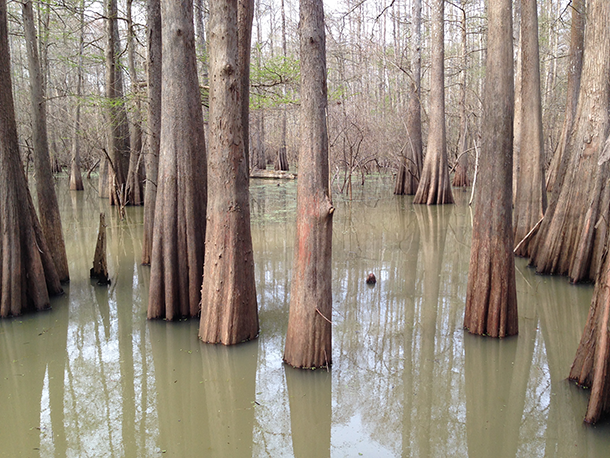
Cypress swamps once covered much of the U.S. South. (Photo: Emmett FitzGerald)
MACON: Forests have just become a complete crop in these areas. They have converted so many many acres of precious wetland areas to monoculture pine plantations. And a pine plantation contains about 95 percent less biodiversity than a native standing forest.
FITZGERALD: But Professor Dale Greene of the University of Georgia says biomass producers aren’t clear-cutting virgin woodlands; they’re mostly operating in forests that have been intensively managed for years.
GREENE: What’s really at the nub of the debate is whether you assume you found the forest, or whether you assume the forest you’re about to harvest is one you planted yourself and invested in and took care of for 20 or 25 years.
FITZGERALD: For the most part Professor Greene says biomass companies are harvesting pulpwood that might have otherwise been used for paper production. Because most of the land in the South is privately owned, he says you need industries like biomass to encourage landowners to keep their property covered in trees.
GREENE: What we’ve clearly seen historically is the stronger the markets for wood the more likely landowners are to replant. And that’s our real threat to our forest acreage, is landowners deciding to harvest their trees and put it into row crops or put it into pasture and put cows on it.
FITZGERALD: And while a pine plantation may not have as much biodiversity as a native cypress forest, it’s better than a pasture.
GREENE: A stand of trees, even if it's a stand of planted pine trees, does much better for our air and water and wildlife habitat than a field of soybeans or a bunch of cows out there on the landscape.
FITZGERALD: Dale Greene says until we can find a better way to store energy from intermittent sources like wind and solar, biomass is one of the only renewable energy sources that’s ready when you need it. But Dean Wilson bristles when he hears the word renewable used to describe forests like the Atchafalaya where we are today.

A clear cut with felled cypress trees in North Carolina. The Dogwood Alliance says this is linked to pellet production. (Photo: Dogwood Alliance)
WILSON: Because what people think when they hear that is that these wild forests in Louisiana are renewable and if you cut them down, they come back. They have the potential in theory to come back but in reality they don’t. And as you can see here they didn’t.
FITZGERALD: He points to a stand of ash trees where a century and half ago cypress stood tall. When loggers cut down the cypress a hundred years ago, different species replaced them because the conditions weren’t right for cypress anymore. Dean says that the hydrology of the region has changed so much since the Army Corps of Engineers started building levees that there’s almost no chance for cypress regeneration today.
WILSON: So anything you cut today, it ain’t going to come back, in this area.
FITZGERALD: It’s unclear whether biomass producers in Louisiana will ever log the Atchafalaya Basin. A British power company called Drax recently built several wood processing facilities in Louisiana, but so far it’s been using pine from plantations. In April, 2015, Dean Wilson met with Drax, and company officials assured him that they would not harvest cypress from wetlands like the Atchafalaya. Drax touts its biomass as sustainably harvested. The company says that it uses mostly waste wood and leftovers from timber harvests, and it doesn’t source from virgin wetland forests, but Adam Macon of the Dogwood Alliance says he’s been to biomass clear-cuts in North Carolina.
MACON: We know from North Carolina and Virginia that this industry and pellet manufacturers such as Drax and Enviva are not above logging in wetland forests, they’re actively doing it and they’re going to be actively doing it in Louisiana if they can get their hands on it.
FITZGERALD: The Dogwood Alliance is working to organize communities across the South to fight the biomass industry and convince Europe to stop subsidizing wood pellet production. Dean Wilson is focused a little closer to home, trying to protect the wetland forest where he lives. But he says it’s hard to convince local people to care about a swamp.
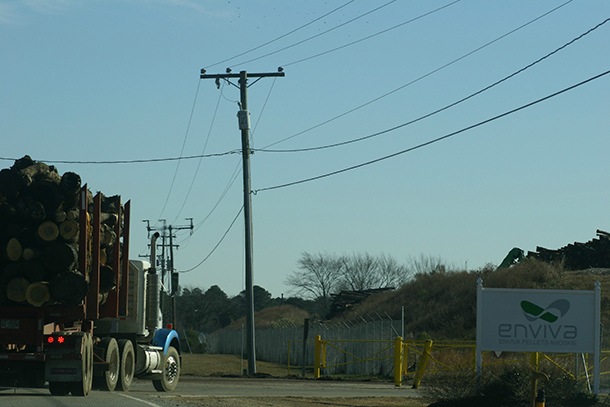
Whole trees entering the Enviva wood pellet manufacturing facilities in Ahoskie, North Carolina. (Photo: Dogwood Alliance)
WILSON: The problem is most Louisianans never been in a swamp. Hollywood give you the image of a swamp being a nasty place. Dead, full of mosquitoes so who cares if they cut it down? That’s what people feel about swamps. I don’t know how to change that.
FITZGERALD: Paul Orr says that whether people know it or not, wetlands like the Atchafalaya are vital to the state. They shelter cities from storms, provide fish habitat for the lucrative seafood industry, and they’re uniquely of this place.
ORR: The swamp epitomizes the culture of Louisiana, sort of the heart and soul of Louisiana, it’s where the Cajun culture evolved and I think you can quantify it by saying like oh it’s important for migratory birds, it’s important for animals, it’s important because it reduces storm surge, but it’s also -- there’s a sort of intangible connection that Louisiana has to the swamp.
FITZGERALD: But Louisiana has also long played host to many of the nation’s extractive industries. Paul Orr says oil, timber, and chemical companies have been pillaging the state’s natural resources for years, and there’s a limit to how much Louisiana can give.
ORR: When all the oil is gone, when all the trees are cut down, what is Louisiana going to have? These are the things that I think are the most important to preserve for future generations because it’s really what makes Louisiana unique.
FITZGERALD: Floating through this flooded forest with Paul Orr and Dean Wilson, two dedicated swamp defenders, I can understand why they don’t want to give this up.
For Living on Earth, I’m Emmett FitzGerald in Louisiana’s Atchafalaya Basin.
Related links:
- Dean Wilson’s organization Atchafalaya Basinkeeper
- Drax pulls out of £1bn carbon capture project
- About Drax
- Investigation: Does the UK's biomass burning help solve climate change?
- UK to build world’s first power plant with negative emissions
- White Rose: Carbon Capture & Storage Project
[MUSIC: Duke Ellington et al, Creole Blues, on Unknown Session Columbia 1979]
CURWOOD: Coming up...the US Navy turns more whale-friendly. That's just ahead on Living on Earth. Stay tuned.
ANNOUNCER: Funding for Living on Earth comes from United Technologies, a provider to the aerospace and building systems industries worldwide. UTC Building & Industrial Systems, provides building technologies and supplies, container refrigeration systems that transport and preserve food, and medicine with brands such as Otis, Carrier, Chubb, Edwards and Kidde. This is PRI, Public Radio International.
[CUTAWAY MUSIC: Gary Burton et al, Ladies in Mercedes, Real Life Hits, ECM 1985]
The Federal Conservation Fund Endangered
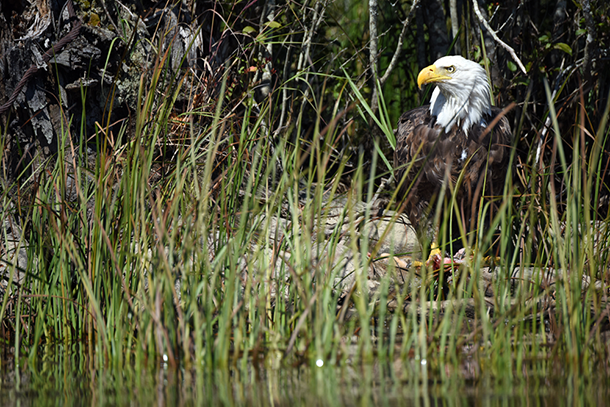
A bald eagle in Lake Umbagog National Wildlife Refuge, enjoying its meal of a fresh-caught fish. (Photo: Derrick Jackson)
CURWOOD: It’s Living on Earth. I'm Steve Curwood. Congress is running out of time to avoid a Government shutdown, and caught in the Capitol Hill crossfire is a tiny budget item with a huge impact on conservation says commentator Derrick Jackson.
JACKSON: There are probably few Americans alive who have not enjoyed the benefits of some of the more than 41,000 projects supported by the Land and Water Conservation Fund. Since 1965, it’s preserved heritage sites spanning civil war battlefields to civil rights monuments, watersheds to hunting grounds and wilderness hiking trails to urban bike paths and skate parks. The fund helps protect and expand prairies, forests, meadows, riversides, seacoasts and city green-space.
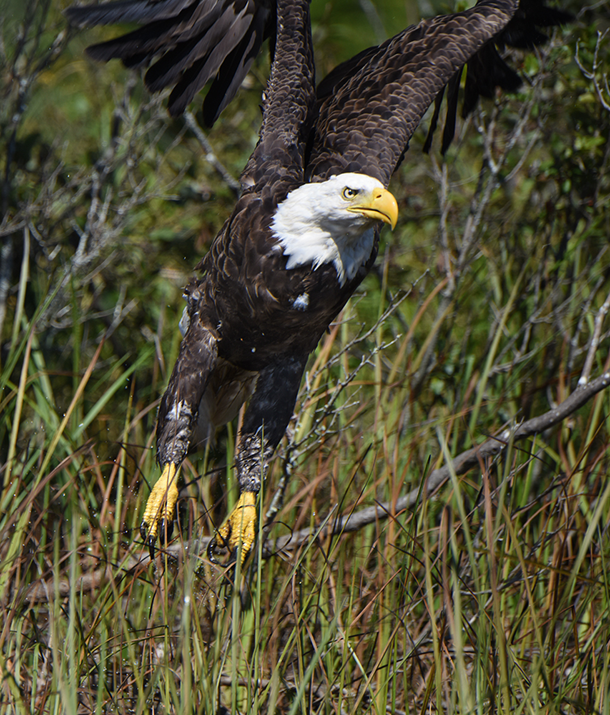
The refuge protects over 20,500 acres of wetland and forested upland habitat along Lake Umbagog, providing homes for bald eagles and other migratory birds. (Photo: Derrick Jackson)
It’s been such a bipartisan success that even the most controversial person ever to lead the Department of the Interior, James Watt in the Reagan era, called the Fund, “one of the most effective preservation and conservation programs in America.” Even today, in a hyper-partisan Congress, many Republicans have signed on to bills that propose to make funding permanent, though the House leadership wants to cut its budget by 38 percent. At the 11th hour, a consensus is building that this is no time to cut the fund.
Last week, I went kayak camping in the Umbagog National Wildlife Refuge in New Hampshire and Maine. With the aid of the Fund, thousands of acres have been added to the refuge. Umbagog is the last place bald eagles nested in New Hampshire in the era of DDT, and the first place they came back after the ban on that dangerous insecticide.
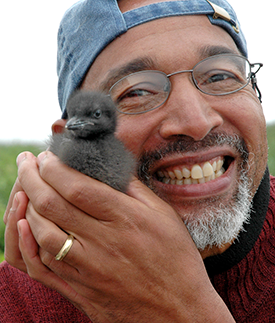
Derrick Jackson is an award-winning op-ed columnist for the Boston Globe and a 2001 Pulitzer Prize finalist. He is the author of the book Project Puffin. (Photo: courtesy of Derrick Jackson)
As I paddled, an eagle blasted out of his tree perch above me and dived into the water for a fish so big and heavy, it could not lift off. It paddled with its wings to shore to eat ignoring a fellow photographer and me as we took portraits from just 50 feet away. For both of us, it was a lifetime moment of intimacy with our national symbol, an intimacy created precisely because the nation gave that eagle a place and the space, thanks to the Land and Water Conservation Fund.
CURWOOD: Commentator and photographer Derrick Jackson.
Related links:
- The Land and Water Conservation Fund Coalition
- Congress is about to let the Land and Water Conservation Fund lapse. Here’s why you should care.
- The Land and Water Conservation Fund must not be allowed to expire
- Why the Land and Water Conservation Fund needs to be reformed
- Lake Umbagog National Wildlife Refuge
- About Derrick Jackson
- Derrick Jackson’s book Project Puffin: The Improbable Quest to Bring a Beloved Seabird Back to Egg Rock
[MUSIC: BIRDNOTE® THEME]
BirdNote: Voices of Our Public Lands
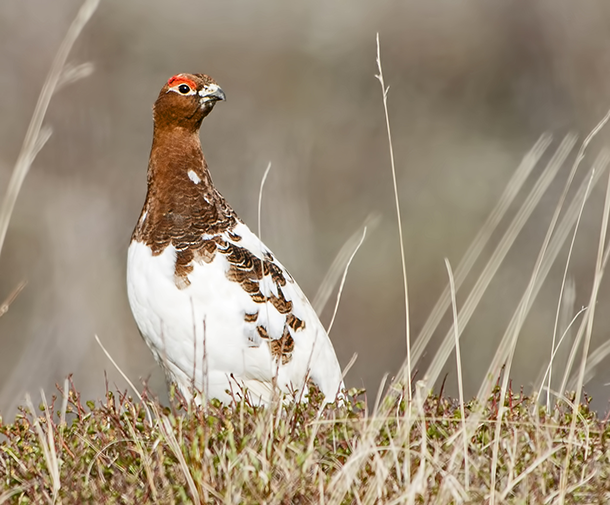
Willow Ptarmigan (Photo: Patty McGann, Flickr CC)
CURWOOD: Well, the Bald Eagle that thrilled Derrick Jackson is an endangered species success story, sufficiently recovered to be delisted 7 years ago, but the Interior Department has decided that the Greater Sage Grouse does not need ESA listing. Its survival will rely instead on specially protected private and public lands.
And on public lands across the country, you’ll find an amazing variety of avians, as Mary McCann points out in today’s BirdNote.
http://birdnote.org/show/voices-our-national-public-lands
BirdNote®
Voices of Our National Public Lands
[Bachman’s Sparrow song]

Bachman’s Sparrow (Photo: ©Joanna Kamo)
MCCANN: The diversity and richness of bird voices across the United States! Wow!
In the Southeast, at Florida’s Ocala National Forest, a Bachman’s Sparrow sings a lovely, clear whistled song.
[Bachman’s Sparrow song]
In the Midwest, at Rice Lake State Park in Minnesota, a Yellow-headed Blackbird offers its gruff repertoire of growls and toots. [Call of Yellow-headed Blackbird]
After dark in the Southwest, at Arizona’s Bill Williams River National Wildlife Refuge, a Black Rail utters its unmistakable call. [Call of Black Rail]
And in Alaska’s Denali National Park, a Willow Ptarmigan chuckles loudly across the tundra. [Call of Willow Ptarmigan]
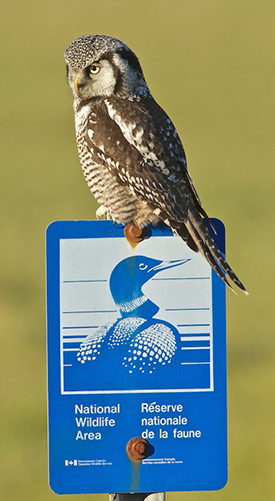
Northern Hawk-Owl (Photo: ©Gregg Thompson)
What remarkable variety in these four bird voices, a variety matched by their geographic locales. But all of these places have something vital in common. They are part of our National Public Lands, lands owned by us, the American people. Comprising nearly 850 million acres of land and 3.5 million square miles of ocean, our public lands and waters provide habitats vital to more than 1,000 species of birds. Now that’s something to crow about! [Call of Willow Ptarmigan]
I’m Mary McCann
###
Written by Bob Sundstrom
Bird sounds provided by The Macaulay Library of Natural Sounds at the Cornell Lab of Ornithology, Ithaca, New York. Song of Bachman Sparrow [166561] recorded by R. Faucett; song of Yellow-headed Blackbird [105686] by G.A. Keller; Black Rail [56890] recorded by G.A. Keller; ambient drawn from Willow Ptarmigan [50031] recorded at Denali by L.J. Peyton.
BirdNote’s theme music was composed and played by Nancy Rumbel and John Kessler.
Producer: John Kessler
Executive Producer: Chris Peterson
© 2013 Tune In to Nature.org September 2013 Narrator: Mary McCann
www.publiclandsday.org
http://www.neefusa.org/programs/index.htm
Bachman’s Sparrow © Joanne Kamo http://www.pbase.com/jitams/image/113389755
Yellow-headed Blackbird - Joseph Higbee FCC https://www.flickr.com/photos/21876608@N02/14009277500
Northern Hawk-Owl © Gregg Thompson
Willow Ptarmigan - Patty McGann FCC https://www.flickr.com/photos/pattymc/9060981651
http://birdnote.org/show/voices-our-national-public-lands
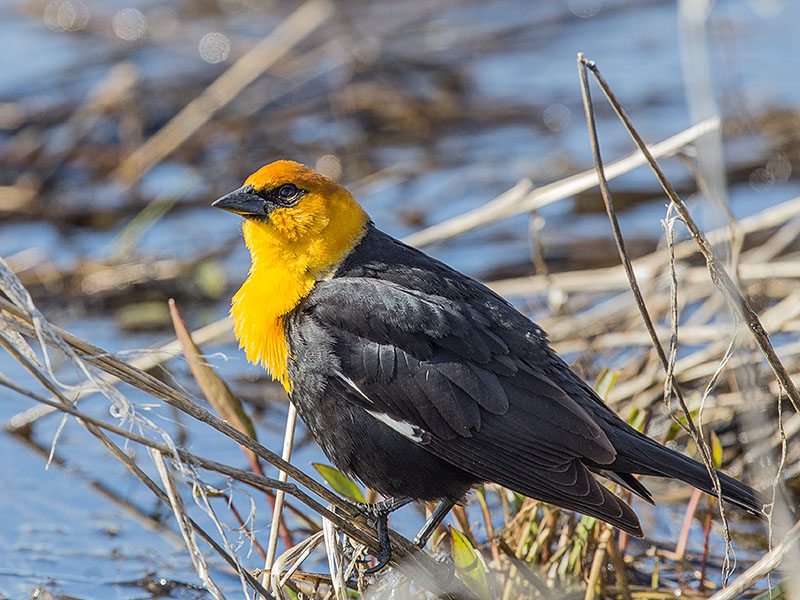
Yellow-headed Blackbird (Photo: Joseph Higbee, Flickr CC)
CURWOOD: For photos of the Willow Ptarmigan and all these other birds including the Bald Eagle, whistle on over to our website, loe dot org.
Related link:
Learn more about birds on public lands on BirdNote
Beyond the Headlines

The green roof at the California Academy of Sciences in San Francisco covers 87% of the Academy’s rooftop. (Photo: opacity, Flickr CC BY-NC-ND 2.0)
CURWOOD: And now let’s check out what’s going on beyond the headlines. Peter Dykstra of the DailyClimate dot org and Environmental Health News, that’s ehn dot org has been scoping that out, and he’s on the line from Conyers, Georgia. Hi Peter!
DYKSTRA: Hi Steve. You know, one of my all-time favorite books from about twenty years ago is called The Geography of Nowhere by Jim Kunstler. It’s an angry, snarky assault on the suburbs, particularly how shopping malls have helped erase main streets and small businesses, and the idea of a public square in so many places. But there’s something cooking in a Silicon Valley town that could reverse that decades-old trend—a failing shopping mall could become the heart of a new town center, all topped off by the world’s largest green roof.
CURWOOD: Well we’ll hear you out on this one, but it all sounds, well, a little too good to be true, Peter.
DYKSTRA: Fair enough, and it’s not true yet, it’s just an idea as reported by the folks at Fast Company. But the Vallco Mall in Cupertino, California has an ambitious plan, and if it’s approved, the owners are committing three billion dollars to turning their half-empty food court and rows of vacant stores back into a vibrant downtown.
CURWOOD: Cupertino is the headquarters for Apple, so there’s got to be a bit of money in that town, right?
DYKSTRA: And one might assume that the folks in Apple’s hometown have a bias to online shopping rather than mall trips, so that maybe explains the failing mall. The Vallco Mall hopes to transform its space with community gardens, farmers’ markets, main street style stores, trails, bike and hiking paths, and a thirty-acre park in place of a mostly-empty parking lot. Let’s wish them luck with a groundbreaking idea.
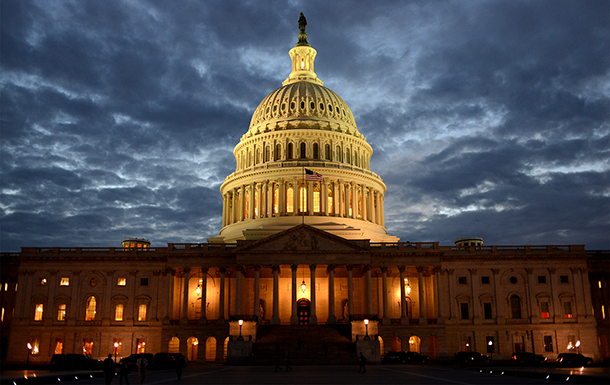
The GOP has a higher proportion of climate deniers compared to the conservative parties from Canada, Australia, New Zealand, and five European nations. (Photo: Stephen Melkisethian, Flickr CC BY-NC-ND 2.0)
CURWOOD: Indeed we should, hey what else do you have today?
DYKSTRA: From the exciting world of social science research—you know, actually this is a little exciting; it’s a lot interesting, and absolutely relevant to the world’s climate politics. Research in the journal Politics and Policy surveyed the major conservative political parties in the U.S., Canada, Australia, New Zealand and five European nations and guess what? American Republicans don’t have an outright monopoly on climate denial, but the phenomenon is far more universal among U.S. conservatives than in their counterparts in the eight other countries surveyed.
CURWOOD: So in these other eight countries, they’ve gotten at least a little bit beyond arguing about whether climate change is a hoax, huh?
DYKSTRA: And only Australian Conservatives oppose measures to regulate carbon. Still, in those eight countries, the dominant Conservative Parties acknowledge that climate change is a problem in need of a solution. In keeping with Conservative philosophy, the solutions are generally market-based, and there’s no blanket rejection of renewable energy. But meanwhile here in the U.S., we had a pitched battle in Congress to turn back the menace of energy-efficient light bulbs. With the crucial climate talks approaching in Paris in December, I found this to be some really good insight.
CURWOOD: Time to drag another gem out of the history vault, Peter. What do you have for us this week?
DYKSTRA: Well, some of us might be feeling a little Poped-out at this point, so here’s another charismatic contemporary religious figure with strong views on human influence on the environment. On September 26th and 27th of 1985, thirty years ago, we witnessed one of the greatest miracles since Noah and the Ark. Hurricane Gloria was bearing down on the East Coast, with Virginia Beach in the bulls eye. The night before, the most famous resident of Virginia Beach took to the airwaves in the face of clear and present danger. That’s right, the Reverend Pat Robertson prayed to rebuke Gloria, and wouldn’t ya know it, Gloria made an abrupt sharp right turn and spared Virginia Beach.
CURWOOD: So at this point Pat Robertson is taking credit, and is there a happy ending?
DYKSTRA: Well, for Virginia Beach and Pat Robertson’s headquarters, maybe. But that sharp right turn took the storm into Long Island and southern New England. Cape Hatteras got a big storm surge; Virginia Beach got doused with rain. Eight people lost their lives in the Northeast after Gloria turned northward for a direct hit.
CURWOOD: So did Pat Robertson acknowledge that Gloria wasn’t 100 percent rebuked?
DYKSTRA: He did, and on his TV show, the 700 Club the next night – the video’s on our website at loe dot org – he actually said that the people of Long Island and New England may not have been praying hard enough. Give the Reverend credit, though, Virginia Beach has a pretty good record of being spared from direct hurricane hits. Pat Robertson says he prayed one away in 1964 and again in 1995.
CURWOOD: Huh, a triple play -- or maybe a ‘triple pray.’ Well, thank you, Peter. Peter Dykstra is with Environmental Health News, that’s EHN dot org and TheDailyClimate dot org. Talk to you next time!
DYKSTRA: All right Steve, thanks a lot, we’ll talk to you soon.
CURWOOD: And as well as the Pat Robertson video, there’s more on these stories at our website, LOE dot org.
Related links:
- The Geography of Nowhere: The Rise and Decline of America’s Man-Made Landscape
- The Largest Green Roof In The World Will Sit On Top Of This Dying California Mall
- On Climate Change, the GOP Is an Outlier
- Pat Robertson explains how he “prayed away” Hurricane Gloria
- The aftermath of Hurricane Gloria
[MUSIC: Miles Davis/Gil Evans/George Gershwin, It Ain’t Necessarily So, Porgy and Bess, Columbia 1959]
Saving Whales From Deafness
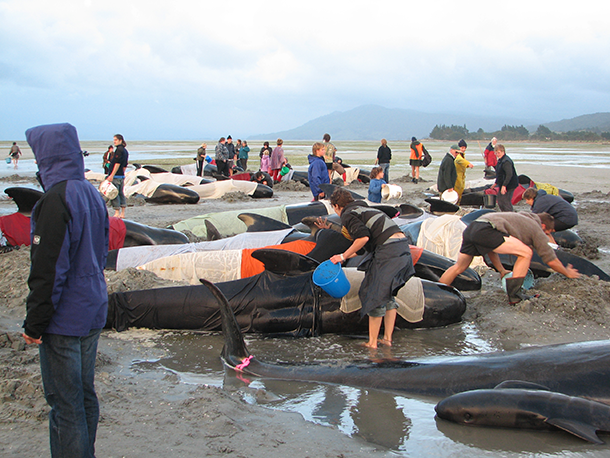
Sonar use can cause whales to beach themselves. Here, volunteers attempt to keep body temperatures of beached pilot whales from rising at Farewell Spit, New Zealand. (Photo: Chagai, Wikipedia public domain)
CURWOOD: The history of whales and humans has not been happy – at least for whales. We hunted some species nearly to extinction, and several countries don’t observe the current hunting ban. Plenty of whales are also maimed or killed by huge cargo ships that plough into them, fishing nets and lines that entangle them and incessant ocean noise that deafens them. Well, now there’s a modest victory for whales off southern California and Hawai’i. In response to a lawsuit brought by the Natural Resources Defense Council, the navy will restrict its use of damaging sonar in key whale habitat. Zak Smith is a senior attorney with NRDC – welcome to Living on Earth, Zak!
SMITH: Thank you.
CURWOOD: What exactly did the Navy agree to do here?
SMITH: Well, the Navy agreed to do several things, most importantly they agreed to set aside certain areas within their range where they conduct training and testing activities and set aside those areas where they won't use particular types of technologies that are dangerous for marine mammals such as sonar and use of explosives. We identified those areas in Hawaii and Southern California that are important to marine mammals and many of those were set aside where they’ll no longer conduct those kind of activities. We also got an agreement that should help reduce the incidence of ship strikes, which are problematic for blue whales and other great whales that migrate along California's coast.
CURWOOD: How did this all come about?
SMITH: Well, it's a long story and I'll give you the short version.
CURWOOD: OK.
SMITH: In 2000, there was a mass stranding of beaked whales and other species in the Bahamas and very quickly some scientists started to link it to the Navy's use of sonar in that area. And a report over time was conducted by the Navy and the National Marine Fisheries Service, which concluded that sonar was in fact the cause of those strandings and deaths of those marine mammals. And kind of since that time, literature has developed, scientific research has been conducted, and NRDC has had several lawsuits in which we have challenged the adequacy of the Navy and the fisheries services analysis of impacts.
So that story kind of continued until close to two years ago, year and a half ago, we sued over the Navy's five-year plan to conduct training and testing activities in Southern California and Hawaii where their own models estimated more than 9.5 million incidences of harmed mammals over five years, hundreds of deaths they asked for authorization for. So, we sued and said that they hadn't done adequate analysis, that they had not prepared adequate measures to protect marine mammals, and we won in court on all claims under the Endangered Species Act, the Marine Mammal Protection Act. And then the question was: Well, how do we then remedy their violations of law? And that's the settlement that we just reached.
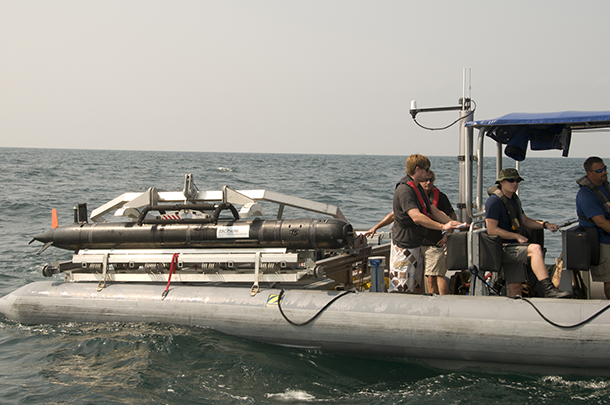
The MK18 sonar is prepared for launch off a rigid-hulled inflatable boat during during the 2011 Mine Countermeasures Science and Technology Demonstration of the Office of Naval Research. The demonstration, hosted by Naval Surface Warfare Center, Panama City Division, is a two-week, in water demonstration testing the latest mine countermeasures mission naval capability technologies. Thirteen projects are participating in the event from June 13-24 off the coast of Panama City Beach, Fla. (U.S. Navy photo by Craig McDonnell/Released)
CURWOOD: How a big deal is this from the perspective of cetacean conservation?
SMITH: This is very important. I mean, it's a huge victory for conservation for marine mammals because what it does is for the first time says, “How can we achieve those national security goals and the training goals that we have while at the same time maximizing protection for marine mammals?” And so, that's for the first time you see that the Navy and the fisheries service sitting down, looking at the biologically important areas that have been identified for different species throughout the ranges and trying to determine whether or not they could set aside those areas or take other steps to limit harm in those areas. And that's something that the Navy had been resisting doing for years and so in that sense it's incredibly significant and it’s a model that should be used for the Navy going forward and could be applicable to other agencies as they plan activities along our coasts.
CURWOOD: By the way, how does sonar impact whales and dolphins?
SMITH: Sonar has a range of impacts that it can have on marine mammals. On one end of the scale, you have outright death. If you're close enough to a sonar source with the kind of high-intensity sound that is emitted from those sources, it can lead to internal organ damage. There are indications of bleeding from the ears and the eyes, so there's those kinds of impacts at the very closest range, the most horrible ones. As you move away from the source and the less severe types of injuries would be permanent hearing loss, temporary hearing loss, which are still incredibly significant for marine mammals. They depend upon hearing for all of their interactions in the environment. The ocean is a very dark place after you get down deep enough where they spend most of their time and many scientists including the great Sylvia Earle have said that a deaf whale is a dead whale, and so even estimates of temporary hearing loss are very concerning. And then it kind of peters out, but it's still incredibly significant behavioral disruptions which are habitat abandonment, interrupting feeding opportunities and over time, those kinds of things subjected to populations day in and day out in these areas can really have an impact on the way in which populations can survive.
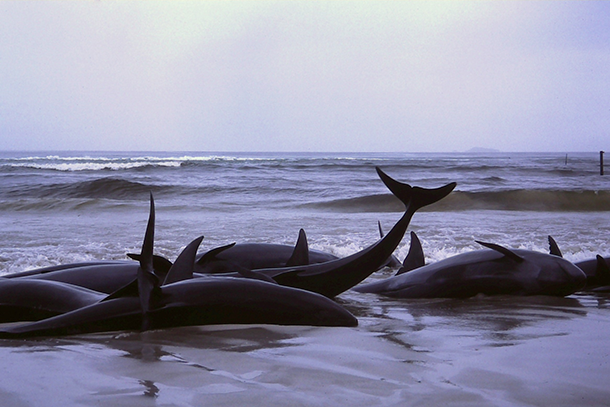
Under the Navy’s five-year plan, they were permitted to harm whales, dolphins, seal and sealions and other cetaceans. The Navy estimated that during that time, its activities would harm those animals 9.6 million times—including instances of temporary or permanent hearing loss, disruption to their behaviors, hemorrhaging, and death. (Photo: Bahnfrend, CC BY-SA 3.0)
CURWOOD: What more does the Navy need to do now?
SMITH: Well, this is a great opportunity. The kind of collaborative effort that we were able to achieve through this settlement is hopefully something we can take to the other ranges where the Navy conducts its activities along the Atlantic coast, in the Gulf of Mexico, where there are even a larger number of impacts to the marine mammals that live within those areas, Pacific Northwest, Gulf of Alaska, the Mariana Islands. There's a lot of areas where our Navy operates and where this kind of approach, which is very common sense, should be the next step.
CURWOOD: By the way, Zak, who else is operating in the ocean making a lot of noise that could be of concern to cetaceans?
SMITH: Well, there's three categories of ocean noise contributors, which are the biggest categories: Navy, some from war games that we've discussed, as well as a shipping noise which is an incredible burden that is placed on the marine environment. They've done a lot of studies about that showing this kind of background noise getting so intense that whales and another marine mammals—it's like being at a rock concert, you have to scream at each other to be heard—so shipping noise is a huge issue and then even more damaging kind of immediately, if you're there, is oil and gas development and that is mostly through the mechanism of seismic exploration. They introduce incredibly loud sounds into ocean and basins and that is a huge problem, especially when you're opening up new areas for naive populations like the Atlantic coast that have been off-limits to oil and gas development for decades as well as the Arctic. So you start to introduce those kinds of things and there have been incidences of stranding events associated with oil and gas exploration around the world. That's another concern and something that we're fighting on.
CURWOOD: Zak Smith is a staff attorney at the Natural Resources Defense Council. Thanks for taking the time today, Zak.
SMITH: Thank you it was my pleasure, and thank you for covering this issue.
Related links:
- Navy Agrees to Limit Underwater Assaults on Whales and Dolphins
- Court Rules Navy War Games Violate Law Protecting Whales and Dolphins
- More about the lawsuit and how naval activity harms cetaceans
[MUSIC: Mike Marshall/Darol Anger, Dolphins, Chiaroscuro, Windham Hill 1985]
Online Exclusive: Airing Volkswagen’s Dirty Emissions
CURWOOD: It’s Living on Earth. I’m Steve Curwood. Volkswagen is “the peoples’ car”, but company management has been pulling a fast one on we the people – cheating to misrepresent just how green its diesel VW and Audi cars are. We called up Dave Cooke, a vehicles analyst with the Union of Concerned Scientists to explain what they did – and why – and what it means for the whole concept of “Clean Diesel”. Welcome to Living on Earth!
COOKE: Thanks for having me.
CURWOOD: So, first, what exactly did Volkswagen do here?
COOKE: Well, the bottom line is that Volkswagen cheated on the tests. Emission tests are run with a vehicle on what is called a dynamometer. A dynamometer is essentially a treadmill for your car. It tricks the vehicle into needing to output the same amount of power as though the vehicle were driving down the road, but it does so by remaining in place, so you can measure emissions at the tailpipe. In this case they were cheating on nitrogen oxide emissions, which are a smog-forming pollutant.
CURWOOD: How was this cheating scandal uncovered?
COOKE: It was uncovered when a team from the International Council on Clean Transportation, together with researchers at West Virginia University, wanted to look at diesel vehicles and show that today’s diesel vehicles are clean. So they tested the vehicles on a dynamometer, but they also then tested the vehicles on the road by actually measuring the emissions while they were being driven, and they discovered that the on-road emissions were significantly higher for the two Volkswagen vehicles they tested than the emissions on the dynamometer test. This raised red flags for them; they then contacted folks at the Environmental Protection Agency and the California Air Resources Board. The California Air Resources Board then did their own testing, confirmed what ICCT had found, and finally Volkswagen had to confess that they had two calibrations and the car could recognize when it was being tested, and was using that calibration, and then on-road it was using a different calibration which then led to significantly higher emissions.
Nitrogen oxides mix with volatile organic compounds released during gasoline combustion to form smog. (Photo: Pag293, Wikimedia Commons public domain)
CURWOOD: The big question here, of course, is what incentive would drive Volkswagen — now this is a company with a longstanding reputation for building affordable, really good and drivable cars — what would prompt them to cheat this way?
COOKE: Well, I think the incentive is very strong. Diesels make up a significant fraction of Volkswagen sales in the U.S. — it’s around 20 percent. When they were forced to halt diesel sales under the emissions standards, they were the first diesel manufacturers to sell vehicles that met the new standards in 2008 — so their 2009 model vehicles were the first. But obviously they were able to do so by cheating the system, and instead of engineering a true solution. They’ve continued to evolve their emissions control strategies since that initial cheat, and what’s surprising is they continued to cheat the system, despite making significant advances in emissions controls.
CURWOOD: So, how does one keep the car industry honest?
COOKE: I think it’s a really challenging point. EPA audits about fifteen percent of the vehicles sold, they do their own testing. But in general they do rely significantly on manufacturer-submitted results, and so they have backup from consumer advocacy groups who do their own testing, or independent research groups like ICCT, can raise some of these red flags to act as a secondary precaution.
CURWOOD: So, what difference might this cheating by Volkswagen mean in terms of the performance of their vehicles?
COOKE: In the case of generation one vehicles — so the first few model years of the Jetta, for example, so 2009 model year — it’s possible that to remedy this problem, you would need to significantly redesign the engine, and actually include a new after-treatment system, which would also have thousands of dollars of cost, in addition to complexity and it would completely change how the engine performs. So if the engine now had to run the emissions control system at its optimal capacity, you could see a decrease in available power for the vehicle. When they figure out a solution to this problem, it is likely that any recalled vehicle will see diminished performance and diminished fuel economy.
CURWOOD: Well, how achievable is “clean diesel”?
COOKE: So one of the concerns that we have here at the Union of Concerned Scientists is that people are going to see this as another knock on diesel technology; and we do believe that you can make diesel clean. Other manufacturers are proving it; we think that diesel has unique performance characteristics that may be more preferable to consumers in certain situations, and so it certainly can be a part of a cleaner transportation future.
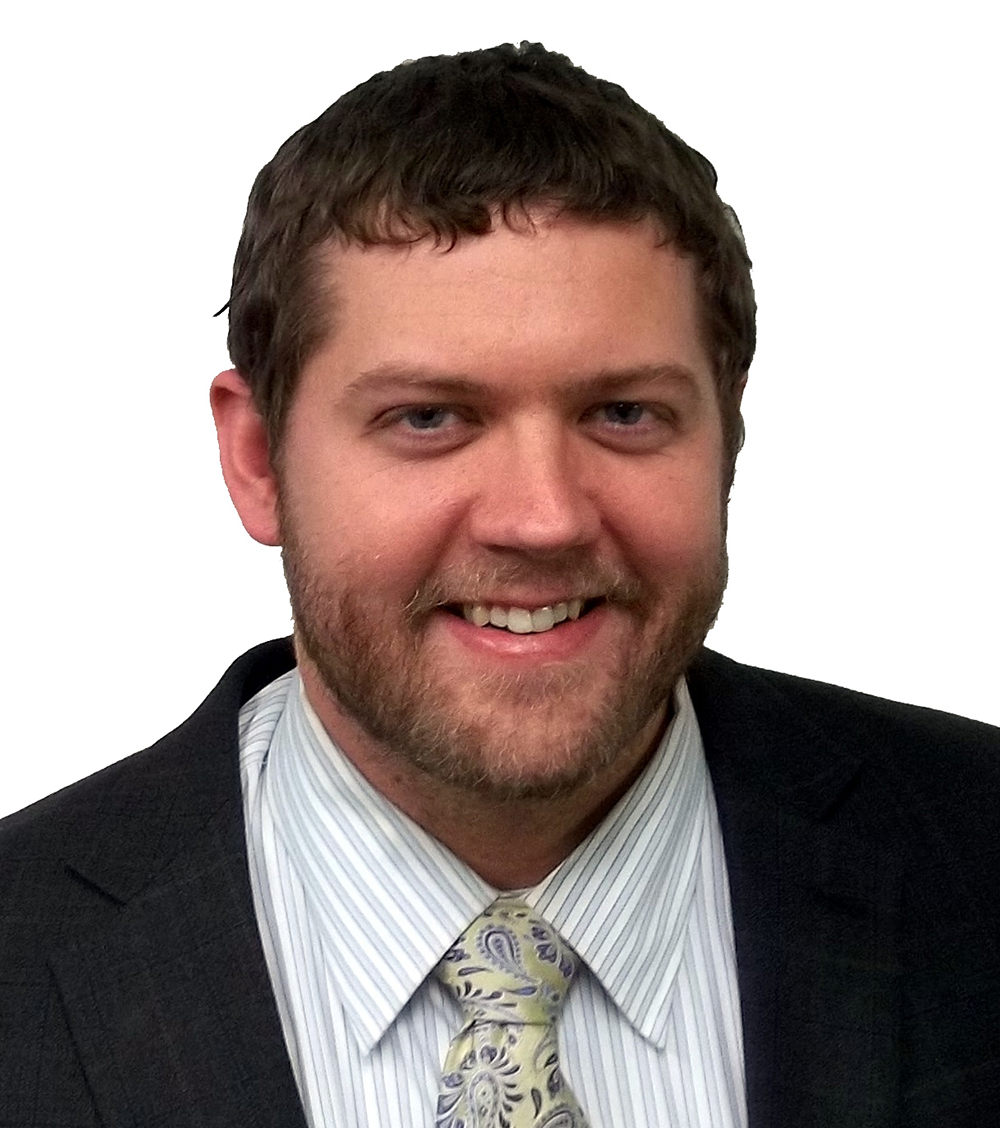
Dave Cooke is a vehicle analyst for the Union of Concerned Scientists. (Photo: Courtesy of the Union of Concerned Scientists)
CURWOOD: By the way, what is the impact of diesel combustion compared to gasoline when it comes to climate-changing gases?
COOKE: What we’ve found is that diesel fuel economy on average is, let’s say, 25 percent better than a typical gasoline counterpart. Part of that comes from the fact that diesel fuel actually has more carbon and is more energy-dense and takes more energy to make, so part of that fuel economy benefit is diminished when you’re looking at CO2 emissions. And so that 25 percent improvement in fuel economy only leads to about five percent reduction in global warming emissions. But that’s still five percent.
CURWOOD: Dave Cooke is a vehicles analyst with the Union of Concerned Scientists. Dave, thanks so much for taking the time today.
COOKE: Thanks for having me.
Related links:
- Dave Cooke’s coverage of the Volkswagen scandal
- VW’s Emissions Cheating Found by Curious Clean-Air Group
- Your Guide to Dieselgate: Volkswagen’s Diesel Cheating Catastrophe
- The ICCT and West Virginia University study that revealed the emissions discrepancy
- “Diesels vs Hybrids: The Costs and Benefits of Both (And a Shiny Calculator!)” by Dave Cooke
- Automaker Rankings 2014: The Environmental Performance of Car Companies
CURWOOD: Living on Earth is produced by the World Media Foundation and brought to you from the campus of the University of Massachusetts Boston, in association with its School for the Environment, developing the next generation of environmental leaders. Our crew includes Naomi Arenberg, Bobby Bascomb, Emmett Fitzgerald, Lauren Hinkel, Helen Palmer, Adelaide Chen, Jenni Doering, John Duff, and Jennifer Marquis. Tom Tiger engineered our show, with help From Jake Rego, Noel Flatt and Jeff Wade. Alison Lirish Dean composed our themes. You can find us anytime at L-O-E Dot Org - and like us, please, on our Facebook page - it’s PRI’s Living On Earth. And we tweet From @Livingonearth. I'm Steve Curwood. Thanks for listening!
ANNOUNCER1: Funding for Living On Earth comes from the Grantham Foundation for the protection of the environment, supporting strategic communication and collaboration in solving the world’s most pressing environmental problems. Support also comes from the Kendeda Fund, and Trinity University Press, publisher of “Moral Ground” Ethical Action for a Planet in Peril 80 visionaries who agree with Pope Francis; climate change is a moral issue for each of us, T-U Press dot org, and Gilman Ordway for coverage of conservation and environmental change.
ANNOUNCER2: PRI. Public Radio International
Living on Earth wants to hear from you!
Living on Earth
62 Calef Highway, Suite 212
Lee, NH 03861
Telephone: 617-287-4121
E-mail: comments@loe.org
Newsletter [Click here]
Donate to Living on Earth!
Living on Earth is an independent media program and relies entirely on contributions from listeners and institutions supporting public service. Please donate now to preserve an independent environmental voice.
NewsletterLiving on Earth offers a weekly delivery of the show's rundown to your mailbox. Sign up for our newsletter today!
 Sailors For The Sea: Be the change you want to sea.
Sailors For The Sea: Be the change you want to sea.
 The Grantham Foundation for the Protection of the Environment: Committed to protecting and improving the health of the global environment.
The Grantham Foundation for the Protection of the Environment: Committed to protecting and improving the health of the global environment.
 Contribute to Living on Earth and receive, as our gift to you, an archival print of one of Mark Seth Lender's extraordinary wildlife photographs. Follow the link to see Mark's current collection of photographs.
Contribute to Living on Earth and receive, as our gift to you, an archival print of one of Mark Seth Lender's extraordinary wildlife photographs. Follow the link to see Mark's current collection of photographs.
 Buy a signed copy of Mark Seth Lender's book Smeagull the Seagull & support Living on Earth
Buy a signed copy of Mark Seth Lender's book Smeagull the Seagull & support Living on Earth

